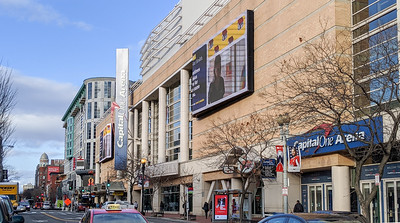The fact is there are two areas of design where the Trump Administration is somewhat correct. It's just their solutions may be bad.
The first has to do with problems in the environmental assessment process, which takes too long--assessments can take many years and the detail is numbing--the EIA for dogs in the various units of the Golden Gate National Recreation Area in the San Francisco Bay region is over 1200 pages. Plus, the process has been weaponized--used as a pretext for lawsuits to delay or scuttle projects--that in many cases is deleterious to public benefit.
So it's reasonable to say the process is flawed and should be improved. But it's unreasonable to require such EIAs to be finished within hyper short periods of time or to ban them altogether.
-- "Trump's Move Against Landmark Environmental Law Caps a Relentless Agenda," New York Times
-- "Trump Admin Faces Outcry over Plan to Weaken National Environmental Policy Act," Democracy Now
US Federal Courthouse in Austin, Texas.
Second has to do with public building design. The Trump Administration has gotten the design profession up in arms
-- "MAGA War on Architectural Diversity Weaponizes Greek Columns," New York Times
-- "Why Trump shouldn’t be allowed to dictate how federal buildings are designed," Washington Post
-- "Why the Trump plan to mandate classical architecture is controversial," Los Angeles Times
-- "The Trump Administration and the New Architects of Fear," Wired Magazine
-- "Trump’s Bizarre Plan to Make Architecture Classical Again," The Atlantic
over a recent action where there is an Executive Order (Make Federal Buildings Beautiful Again) proposes going forward that most federal buildings be constructed using "classic architectural designs."
From "The Unbuilt Nazi Pantheon: Unpacking Albert Speer's "Volkshalle"," ArchDaily.
People bring up Albert Speer and the Nazis, but the fact is that in recent times the public and civic qualities of federal buildings have been lost in the execution of modern designs as well as the post 9/11 security requirements, which make such buildings hard to integrate in urban settings without walls, moats, bollards and other interventions.
Although given the crass design sensibility exhibited by President Trump in his previous career as a developer, it's not unreasonable to be concerned and to reference Albert Speer.
 Also see "Yuge erections: The mysterious power of Trump’s garish buildings," The Economist.
Also see "Yuge erections: The mysterious power of Trump’s garish buildings," The Economist.Much of the discussion in the media hasn't adequately addressed this issue, which is complicated by how in modernism, all buildings "look the same" regardless of type so that you can't tell if a building is a courthouse, an office building, an apartment building, or a hospital.
When I first started getting involved in these issues around 20 years ago, I came across some important articles in the no longer published Planning Commissioners Journal:
-- "Public Buildings Should Set the Standard," 2001
-- related overview, "Why public buildings are important to planning"
-- web feature of postcard images of public buildings from the early 1900s
-- "Public Buildings Keep Town Centers Alive," 2003
From the first article:
People appreciate public buildings that express the dignity, permanence, and importance of civic institutions, and which harmonize with their surroundings. In recent years, there have been a growing number of instances where communities have demanded higher quality in the design of new public buildings and resisted efforts to move post offices, city halls, and other civic institutions to out-of-the-way locations.By contrast, car-oriented and security focused building designs often make public buildings poor contributions to town centers.
And I have written about this quite a bit myself, including:
-- "The DC Central Library, the Civic identity and the public realm," 2011
-- "Transit, stations, and placemaking: stations as entrypoints into neighborhoods," 2013
-- "Transportation infrastructure as civic architecture," 2016
Chuck Marohn on the Strong Towns website, has a piece, "Make Federal Buildings Great Again (sigh)," similar in sentiment to the PCJ articles.
Old Courthouse, Glynn County Georgia

New Courthouse, Glynn County Georgia (1991) -- pretty good for new construction

US Courthouse, Greenbelt, Maryland

Children's Hospital, DC

Pittsburgh Water Treatment Plant

Capital One Arena, Washington, DC

Cleveland Severance Hall

Martin Luther King Library, DC

Old Carnegie Library, DC



Art in America argues that
ReplyDeleteTRUMP CAN’T MAKE ARCHITECTURE GREAT AGAIN WITHOUT AN INFRASTRUCTURE PLAN
https://www.artnews.com/art-in-america/features/trump-make-architecture-great-again-maga-classicism-1202677813
2/13/2020
But the reality the two don't have to be connected.
Catesby Leigh in City Journal
ReplyDeletehttps://www.city-journal.org/classical-architecture-federal-buildings
Makes a similar point, that the place value of federal architecture over the past decades isn't particularly great.
https://www.governing.com/community/Modern-Classics-The-Rebirth-of-Civic-Architecture.html
ReplyDelete4/20
Finding 3d Rendering Services Company For Quality Design
ReplyDeleteQuickgunz Pvt Ltd Offer 3d Rendering Services With High-quality Work 1920 Pixel Design Render At Nominal Prices. So If You Want To Design Renders For Your Upcoming Projects Then You Are On Right Place Where We Provider Every Kind Of 3d Rendering Services Like Solidworks, product, Commercial, residential, Machinery Etc
For Book Our Services Let Me Know At Our Website Where All Information Will Be Updated
3D Rendering Company